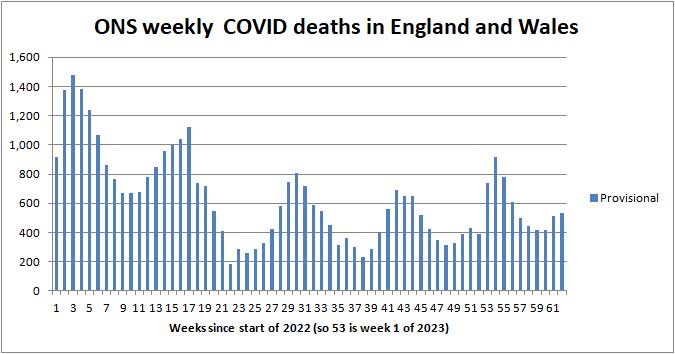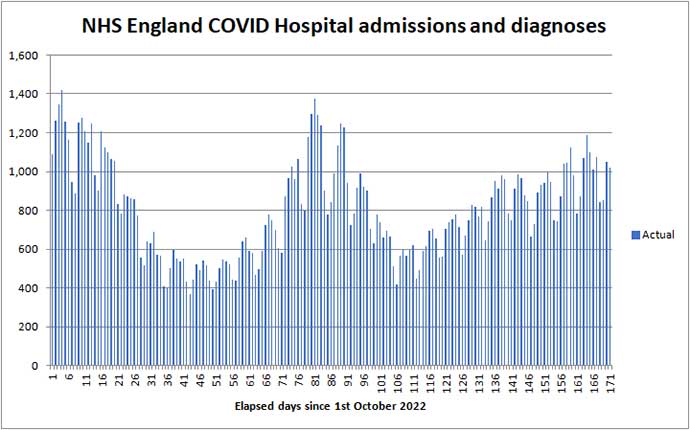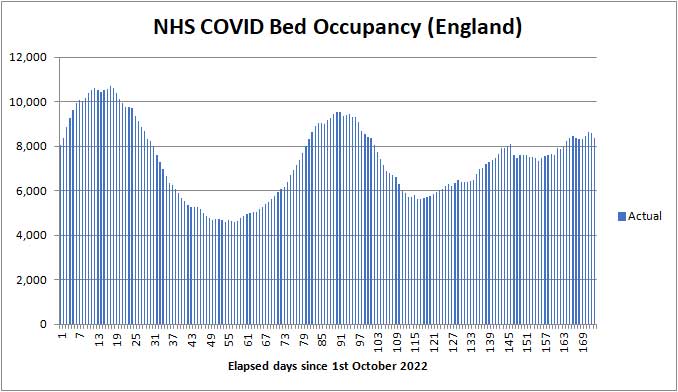
Angus and Rosemary's Miscellany
of Malvern - Other Resources
|
Coronavirus (COVID-19) epidemic weekly update for Malvern SeniorsNew cut down version Click to read our observations on politics and world events 26th March 2023
Prevalence remains high so don't be too surprised if some of your friends catch a mild dose. PreambleFor almost three years we have been keeping an eye on the published government figures and monitoring the media to asses the likely level of risk for Seniors in the Malvern Hills district and providing links to where further information could be found. Government reporting of COVID figures is being cutback at the end of March 2023 so our blog, which is usually updated every Sunday, may shrink during coming weeks as data dries up. Hospital admissions, beds and deaths are now the primary measure of the tail of the epidemic in the UK. ContentsSummaryThe incidence of COVID-19 remains quite high with about 2.6% of the population infected at any one time. Last week, hospital admissions and bed occupancy reached a plateau so could drop next week. By early April, the COVID death rate in England and Wales may increase from 500 towards 700 deaths per week, which is nothing to be alarmed about as few deaths are in Worcestershire. These are 'baked in' deaths - relating to people already infected. Vaccination and natural immunity, following infection, continue to protect most of the population from severe illness and death. Spring boosters for those aged 75+ wishing to top up their immunity should become available next month. If you catch COVID for a second or perhaps even a third time it is likely to be a mild illness, though you might feel quite poorly and be left feeling very tired. (Definitions: mild = treatable at home; severe = treated in hospital). What happens if you get sick with COVIDIf you are feeling poorly it might not be COVID-19 but some other respiratory illness. If you still have a stash of Lateral Flow Tests you could test yourself at home. However be aware that a negative test does not guarantee you don't have COVID. Whatever the virus best stay at home until you feel better, and wear a face mask to protect others if you do have to go out. Nowadays, you might not know it's COVID and brush it off as just another cold. The top six symptoms last reported through the Zoe app were, sore throat, runny nose, blocked nose, sneezing, headache, and cough. Despite vaccination, some of those who have caught COVID report either getting easily tired or suffering from shortness of breath for some weeks afterwards; if so patients are advised to take it easy until fully recovered as there seems to be no treatment. A small number of patients (less than 10%) report debilitating symptoms for months after so-called recovery especially middle aged women. For example see Dez Medinger and Danny Altmann's book The Long COVID Handbook in bibliography. PrecautionsVaccination SitesInformation about the Spring Booster Campaign is awaited. It is anticipated jabs will become available in GP surgeries for those aged 75 years and over, and the clinically vulnerable, in April 2023. If necessary you can refer to archived blogs (see menu of archived pages).
|
| Date report published | Prevalence (England) | Ratio of people with COVID |
| 17th February 2023 | 1,054,200 | 1:55 |
| 24th February 2023 | 1,223,000 | 1:45 |
| 3rd March 2023 | 1,298,600 | 1:45 |
| 10th March 2023 | 1,333,400 | 1:40 |
| 16th March 2023 | 1,322,000 | 1:40 |
| 24th March 2023 | 1,493,200 | 1:38 |
Prevalence of COVID-19 in England estimated by ONS
Prevalence was estimated 1:40 in Wales; 1:50 in Scotland; and 1:70 in Northern Ireland.
Cases mostly increased in children aged 2 - 11 and those aged over 50 years.
Zoe Health Study
The ZOE Health Study estimates are shown in the following table.
| Date of screenshot | Prevalence (UK) | Estimated new infections per day |
| 16th February 2023 | 1,206,030 | 99,032 |
| 23rd February 2023 | 1,277,787 | 92,168 |
| 2nd March 2023 | 1,271,693 | 88,670 |
| 10th March 2023 | 1,221,821 | 81,851 |
| 17th March 2023 | 1,334,080 | 127,914 |
| 2rd March 2023 | 1,404,346 | 111,241 |
Prevalence of COVID-19 in UK estimated by the Zoe Health Study
According to the more recent Zoe figures, estimated prevalence has risen by 5% while daily cases fell by 13% in the last 6 days.
The fall in daily cases correlates with Hospital bed occupancy levelling off.
 Number
of deaths
Number
of deaths
Statistics on COVID deaths are published by Public Health England, The Office of National Statistics, and NHS England. These can't be directly compared as they cover different periods, but together the figures paint a picture of the direction of travel - which is that the COVID-19 death rate is beginning to rise, though not to a level to be concerned about.
PHE figures
The Dashboard chart of COVID (28) deaths, following a positive test, by date of death shows that the 7 day average peaked in England at 167 deaths per day around 30th December; marking the peak of the Winter Wave.
Since then deaths dipped before peaking again at about 120 deaths per day around 14th March.
Click to view the UK government Coronavirus Dashboard
The PHE figures include people who die with COVID but not from it so are likely to be higher than the ONS numbers.
ONS figures
The Office of National Statistics (ONS) reports registered deaths in England and Wales where COVID-19 is mentioned somewhere on the death certificate. The ONS figures lag real time by 10 - 14 days due to the administrative delay in submitting and processing reports, and do not include Northern Ireland and Scotland.
Note: the figures include cases where COVID may have been a secondary cause of death.
Click for ONS data on deaths (Excel spreadsheet)
ONS figures for Worcestershire by date reported
The ONS figures can be filtered by Local Authority providing a glimpse of where deaths are occurring. The provisional cumulative total of COVID related deaths in Worcestershire reported by the ONS up to 10th March (week 10 of 2023) is shown in the table below.
Note: these numbers are derived from Table 1 of the ONS Death Registrations spreadsheet using the in-built filters. This gives the provisional total of deaths registered in any week, which can be distorted by delayed reporting, for example, due to public holidays.
Deaths by Welsh Health Boards are excluded to avoid duplication as these are totals of Local authorities.
| Districts of Worcs |
Deaths 2020 |
Deaths 2021 |
Deaths 2022 |
Deaths 2023 |
Week 10 | Population |
| Bromsgrove | 164 | 142 | 59 | 11 | 0 | 98,529 |
| Malvern Hills | 61 | 98 | 74 | 9 | 2 | 77,545 |
| Redditch | 108 | 109 | 47 | 10 | 0 | 85,317 |
| Worcester | 87 | 134 | 51 | 6 | 0 | 103,542 |
| Wychavon | 157 | 154 | 85 | 15 | 2 | 126,240 |
| Wyre Forest | 171 | 132 | 62 | 8 | 0 | 100,957 |
| TOTAL | 748 | 769 | 378 | 59 | 4 | 592,130 |
Provisional cumulative COVID-19 deaths in Worcestershire registered by ONS to 10th March 2023.
There was 1 death in a care home and 1 in hospital in the Malvern Hills; and 2 death in hospital in Wychavon.
The general picture continues to be of a 'handful' of weekly deaths in Worcestershire.
ONS figures for England and Wales by date reported
In England and Wales 532 COVID-19 related deaths were reported in the week to 10th March, 19 more than the week before and a rise of about 4%. Of these 89 were in care homes, 23 at home, 20 in a hospice, 399 in hospital and 1 elsewhere.

ONS provisional deaths 'by week reported' in England and Wales since the start of 2022 (so week 53 is week 1 of 2023)
The cumulative total of 2023 COVID deaths registered by ONS in England and Wales to 10th March is 5,835.
ONS figures for England and Wales by date of death
Table 2 of the ONS spreadsheet gives England and Wales figures by date of death. This is a more accurate metric but it takes an additional two to three weeks for most of the registrations to flow in; see extract in the table below.
| Week of 2023 | Number of deaths reported last week |
Number of deaths reported this week |
| 1 | 812 | 813 |
| 2 | 689 | 691 |
| 3 | 571 | 573 |
| 4 | 449 | 451 |
| 5 | 423 | 425 |
| 6 | 395 | 400 |
| 7 | 401 | 409 |
| 8 | 426 | 447 |
| 9 | 296 | 474 (incomplete) |
| 10 | - | 405 (incomplete) |
ONS weekly deaths in England and Wales - 'by date of death'
The peak of the Winter Wave appears to have settled at about 813 deaths per week.
Of the 532 deaths reported in week 10, only 405 deaths were in that week. The latter figure will rise as reports of deaths in that week continue to flow in. Once the total this week is close to the total the previous week, the number 'by date of death' can be considered fairly stable.
Deaths in week 9 look like ending up about 500.
Comparison with deaths from all causes
ONS registered 11,389 deaths from all causes in week 10 in England and Wales so currently COVID deaths are about 4.4% of all deaths.
Many of these are said to be of the elderly who die a few months earlier than they might otherwise do. COVID is perhaps an extra burden which pushes the very frail over the edge.
Click for ONS Coronavirus (COVID-19) latest insights: Deaths
So far there have been 135,556 deaths from all causes in England and Wales in the first 10 weeks averaging 13,555 per week.
Averaged over recent years roughly 1,700 people die daily from all causes in the UK; (deaths are higher in the winter and lower in the summer).
ONS overview of deaths in England and Wales in week 10
ONS provides a commentary on deaths here:-
Click for deaths registered weekly in England and Wales, provisional: week ending 10 March 2023
Sometimes deaths are higher than in past years, but ONS say the number of deaths from all causes was below the five-year average in England and Wales in week ending 10th March 2023 (week 10).
NHS England figures for deaths
NHS England say the reporting of COVID deaths on the NHS website will cease at the end of March 2023.
Quote:
At the end of March 2023, publication of COVID-19 deaths information on the NHS England website will cease, with the last publication on Thursday 30th March covering data up to 29th March 2023. 'Similar information' on COVID-19 deaths will continue to be published and made available on the Coronavirus Dashboard.
It is a pity the NHS will no longer be directly reporting this data which may find its way into the ONS Dataset - 'Death registrations and occurrences by local authority and health board' (Excel spreadsheet) though possibly not in such detail.
NHS England figures for Worcestershire
The table below shows the latest COVID deaths in Worcestershire hospitals reported by NHS England on 23rd March 2023.
| Worcestershire | Cumulative deaths | Past week |
| Acute hospitals | 1,277 | +8 |
| Care hospitals | 99 | +0 |
| TOTAL | 1,376 | +8 |
Excludes deaths in care homes, deaths at home and deaths in hospices.
Note: the increase is the difference between this week's cumulative total and that last reported.
Click for NHS COVID-19 total announced deaths
Look for COVID Total announced deaths file, then select tab Deaths by Trust.
This week's increase is unusually high.
Risk of COVID-19 death by age band
NHS England provides an analysis of COVID-19 deaths in hospital in England and Wales by age band. Shown below is a snapshot of 2,898 deaths for the period 6th May 2022 to 6th July 2022 when most of these deaths will have been from the Omicron variants.
| Age band | Number of COVID deaths | % of deaths |
| 0 - 19 | 8 | 0.3 |
| 20 - 39 | 25 | 0.9 |
| 40 - 59 | 165 | 5.7 |
| 60 - 79 | 1,010 | 34.9 |
| 80+ | 1,692 | 58.4 |
Relative risk of COVID-19 death by age band May - July 2022
The main point to note is those aged 60+ still account for 93% of deaths despite young people being more likely to catch COVID-19.
The risk profile for Omicron appears to be the same as for Delta. Age is still the greatest risk factor; perhaps reflecting that older people have more health problems.
According to the Coronavirus Dashboard sex is an additional risk factor - males are roughly 50% more likely to die than women; possibly because women have a stronger immune system.
 Healthcare numbers
Healthcare numbers
The UK government Coronavirus Dashboard includes information about healthcare statistics and NHS bed occupancy.
| Hospital COVID cases (England) | Number | Last week |
| Patients currently in hospital | 8,387 | -47 |
| Patients on ventilation | 172 | -12 |
| Patients admitted daily | 993 | -15 |
Headline summary of patients in hospital reported on 23rd March 2023
The figures suggest new daily cases have stopped rising.
Note: 'Patients admitted daily' is the weekly total divided by 7. This number includes both patients admitted to hospital with COVID-19 from the community, and those diagnosed with COVID-19 in hospital.
See charts on the Coronavirus Dashboard and below.
Daily hospital admissions in England
This chart of daily COVID hospital admissions and diagnoses also suggests the increase since the middle of January 2023 has peaked.

Daily admissions from 1st October to 26th March 2023
Bed numbers by region in England
Tabulated figures for COVID bed occupancy in England can be found on the NHS England website providing another indicator of the prevalence of COVID.
Click for NHS England COVID-19 Hospital bed Activity statistics
Note: see the latest Daily Admissions and Beds spreadsheets, then look for all COVID beds.
| Region | 16th March 2023 | 23rd March 2023 | 15th January 2021 |
| England | 8,434 | 8,387 | 33,362 |
| London | 1,426 | 1,370 | 7,811 |
| Midlands | 1,570 | 1,692 | 5,890 |
Comparison of All beds COVID data for England, London and Midlands
In the last week the number of COVID-19 General and Acute beds fell by 0.5% in England, 4% in London, and rose by 7% in the Midlands.
For comparison, the number of beds occupied during the peak of the epidemic in January 2021 is shown in red in the right hand column of the table.
The chart below shows how COVID bed occupancy may be reaching a plateau.
Note: the peak in beds is seems to be roughly one week delayed on the peak in daily admissions, and deaths lag beds by a further week.

COVID bed occupancy in England from 1st October to 20th March 2023
 Worcestershire
hospital beds
Worcestershire
hospital beds
Between 14 March 2023 and 20 March 2023, 50 patients went into hospital with coronavirus. This shows an increase of 22% compared to the previous 7 days. There were 80 patients in hospital with coronavirus on 22 March 2023 twenty more than the week before; one on a ventilator.
Click for Summary of Malvern numbers on the Coronavirus dashboard
Forecast for the week ahead
COVID related weekly deaths registered in England and Wales could fall somewhere in the range 500 to 600 in week 11 of 2023 to be reported by the ONS on 28th March.
In the county of Worcestershire, based on 50 new hospital cases last week and assuming the ratio of all deaths (including those in care homes and at home) to be 1:11 of admissions, then one might expect no more than 5 COVID deaths per week in early April 2023.
NHS COVID bed occupancy in England is expected to fall slightly next week.
Longer term outlook
The weekly COVID ONS death rate (by date of death) in England and Wales peaked at about 813 deaths per week around 1st January 2023 roughly coinciding with a peak in hospital bed occupancy of 9,500.
After dipping, NHS hospital bed occupancy in England has crept back up and may be levelling off at about 8,400 COVID beds.
If deaths are proportional, the ONS death rate could creep up from 500 towards 720 deaths per week by early April. These are 'baked in' deaths - relating to people already infected.
Note: deaths this week did not rise as much as expected so the possibility of deaths peaking below 700 per week cannot be ruled out.
UCL modelling
The latest UCL projection is that the 7-day average of daily (certified) deaths may peak at over 100 per day (700 per week) about 7th April 2023 and then fall to less than 50 per day for the remainder of the year.
Based upon present trends, that projection looks credible.
Click for UCL Long-term forecasting of the COVID-19 epidemic
Advice for Seniors
We judge the risk of exposure to COVID-19 remains quite high in England, while there are many other seasonal respiratory viruses circulating that could make you feel just as sick.
There is no evidence that COVID is currently causing alarming numbers of people in Worcestershire to fall severely ill; so for most, the risk might perhaps now be considered LOW.
Consequently we have moved our riskometer to LOW (see opposite).
Many, perhaps most, healthy people continue to take the view that COVID is no longer a critical threat to their health.
For the more cautious the simple safeguards to protect against all respiratory infections, are to:
-
make sure your vaccinations are up to date, noting booster jabs for 75+ expected in April.
-
wash your HANDS thoroughly, using soap and hot water, for 20 seconds, including after handling deliveries to your home, to kill virus picked up from contaminated surfaces (see note 1);
-
ideally wear either a well fitting FACE covering, or better still an FFP2 (N95) face mask when in crowded settings for example when in shops, theatres, health-care settings, when using public transport, and travelling by air;
-
SPACE at least 2 metres from people you don't feel safe with (see note 2);
-
preferably socialise with friends and other households outdoors in the FRESH AIR else, if you are indoors, either ventilate by keeping windows open as far as is practicable or consider putting a HEPA air purifier in the room;
-
avoid crowded indoor settings and friends and colleagues with cold and flu like symptoms;
-
stay at home to protect others if you yourself feel unwell with cold or flu like symptoms;
-
respect others and give them space;
Notes:
1) Wash your hands thoroughly before touching your face to avoid transferring virus from contaminated surfaces to your mouth, eyes and nose. If outdoors, for example filling the car up with fuel, either wash hands with an alcohol based hand gel after touching suspect surfaces or wear gloves.
2) Two metres is further than you think - roughly an arm and a walking stick away.
3) If you are 'clinically vulnerable' consult your GP or specialist; you may need to take a test and consider anti viral drugs if testing positive.
Annex
Commentary
The message this week is the government is ramping down COVID surveillance, silently inferring that as far as they are concerned the pandemic is over.
Meanwhile COVID-19 continues to circulate at quite a high level with an estimated 2.5% of the population likely to test positive at any one time. This is in contrast to Flu which peaked at a similar level to COVID in December but has largely gone away.
In future weeks COVID surveillance will become largely through monitoring NHS hospital admissions and bed occupancy, and deaths reported by ONS.
Vaccination, and natural immunity following infection, should continue to protect most of the population from severe illness and death.
However some patients, less than 10%, may suffer from Long COVID with symptoms such as extended tiredness for which there is no treatment. For that reason it is not a good idea to expose yourself to COVID unnecessarily.
Spring booster vaccinations for those aged 75+ years are expected to become available in April 2023 for those that want them.
Independent SAGE
The following are notes from this week's Independent SAGE fortnightly update which you can watch by clicking the link below.
Click to watch Independent SAGE update on 24th March 2023
The ONS Infection Survey to monitor the prevalence of COVID has been paused.
The COVID-19 Genomics UK Consortium (COG UK) which monitors new variants is being retired.
However look out for further UKHSA technical briefings which may shed a light on what is going on.
About 2.7% of the population are testing positive for COVID but this varies by age. Only 2% of those aged 2 to 11 years are testing positive, rising to 5% in those aged 75+. That's slightly concerning as the elderly are more likely to become severely ill and that could be why the NHS will be offering Spring Boosters next month.
Two thirds of COVID hospital admissions are of those aged 85+ years, with the remaining third being mostly in the age range 65 - 84 years. Severe illness continues to afflict the elderly in most cases.
Only 40% of those occupying COVID beds are being treat for COVID with the remaining 60% found COVID positive while being treated in hospital for something else.
COVID cases continue to occupy hospital beds and delay operations.
The XXB.1.9.1 variant could be the next to be of significance.
Independent SAGE went on to discuss Long COVID.
(We skipped through much of this, so if interested best you watch the video).
It is thought roughly 1.7M people have self declared Long COVID extending beyond 12 weeks, but only a smaller number suffer so badly their daily life is severely affected.
There are still no effective treatments backed up by clinical trials, and some doctors think it's all in the mind.
An ONS report on Long COVID is expected on 30th March 2023.
The ONS report - Prevalence of ongoing symptoms following coronavirus (COVID-19) infection in the UK was to have been published on the 2nd March but has been delayed for further review and is now expected to be published on 30th March 2023.
List of vaccines
Section deleted. Refer to archived pages for historical information about vaccines.
Summary of Links
Some of this information is now out of date but provides a historical context to the epidemic.
Information about Coronavirus can be found on the NHS website:
https://www.nhs.uk/coronavirus
Symptoms
Note: the list of symptoms was updated on 1st April 2022
Article about the effects of Wuhan Coronavirus on the human body
Reporting and how to obtain a test
How to get a test
https://www.nhs.uk/coronavirus
About joining the Zoe COVID Symptom Study:
Guidance
UK government Coronavirus guidance
See also - government sets out next steps for living with COVID
COVID-19 Response: Autumn and Winter Plan 2021 for England
UK Health and Security Agency (UKHSA) website
COVID Alert states
Guidance on UK COVID-19 alert level methodology: an overview
COVID-19 Alert Level lowered to 3 on 10th May 2021
Tiers
Guidance on tiers: what you need to know
Government postcode checker to find tier for other areas
Statistics
UK government COVID-19: Omicron daily overview
UK government Coronavirus Dashboard
Coronavirus Dashboard Interactive Map
ONS data on deaths in England and Wales (Excel spreadsheet)
NHS England COVID-19 Daily Deaths
NHS England COVID-19 Hospital Admissions
NHS England vaccination statistics
Worcestershire Coronavirus Dashboard
Worcestershire COVID-19 Vaccinations Dashboard
HSA COVID-19 vaccine weekly surveillance reports
Information about NHS hospital bed numbers: past, present, future
A glimpse of the worldwide vaccination situation can be found on the Our World in Data website.
Click for chart showing % vaccinated
A video with Dr John Campbell and mathematician Professor Fenton explaining the various ways in which RISK can be specified.
Risks and benefits with Professor Fenton
Modelling
A forecast of the progression of the COVID-19 epidemic can be found on a University College London (UCL) website.
Click for UCL Long-term forecasting of the COVID-19 epidemic
A projection of the future COVID-19 death toll and daily deaths can be found on The Institute for Health Metrics and Evaluation website.
Click for IHME projection of COVID-19 deaths
Reports
Coronavirus (COVID-19) latest insights by ONS
A live roundup of the latest data and trends about the coronavirus (COVID-19) pandemic from the ONS and other sources.
MedRxiv is a US preprint server for Health Sciences. A depository for reports which have still to be peer reviewed.
COVID-19 rapid guideline: managing the long-term effects of COVID-19
NICE guidance on managing Long COVID
The bigger picture
Worldometer summary of coronavirus cases worldwide
European Centre for Disease Prevention and Control info
https://www.ecdc.europa.eu/en/geographical-distribution-2019-ncov-cases
World Health Organisation info
Window on the USA
Centre for Disease Control (CDC)
Find maps and charts tracking cases, deaths, and trends of COVID-19 in the United States.
American Association of Retired People (AARP)
Worcestershire
A local summary of COVID data can be found on the Worcestershire Coronavirus Dashboard.
Note 1: use the arrow <> buttons at the bottom of the Dashboard screen to move between pages.
Note 2: the figures for COVID cases are becoming meaningless as testing is run down.
Note 3: deaths are on page 7, and hospital beds on page 9.
Click for Worcestershire County Council COVID-19 news
There is a colourful webpage offering advice on learning to live with COVID for those aged under 30 years. 'Rona' is slang for Coronavirus.
Click for The Worcestershire 'Rona' Hub
Click for Simple Summary of Malvern numbers on the Coronavirus dashboard
Miscellaneous
Spanish Flu
Dr Jeff Kildea's commentary about the 1919 outbreak of Spanish Flu in Australia
Views of Martin McKee, Professor of European Public Health
Follow Martin McKee on Twitter
Views of Prof Christina Pagel, a member of Independent SAGE
Follow Christina Pagel on Twitter
SAGE membership
Scientific Advisory Group for Emergencies (SAGE)
Scottish government:
Link to Scottish Government website
Link to Postcode checker for COVID restrictions by protection level in areas of Scotland
Welsh Government:
Guidance on COVID alert levels in Wales
Bibliography
Woolhouse, Professor Mark, The Year the World went Mad, published 2022 by Sandstone Press Ltd, ISBN: 978-1-913207-94-3
Medinger Dez, Altmann Danny, The Long Covid Handbook, Penguin Books, 2022. Kindle version available.

The interpretations and opinions expressed are our own
Last updated 26th March 2023
 Blogs
>
Blogs
>